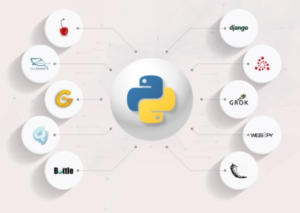Neural networks and deep learning have revolutionized the field of artificial intelligence and have become popular techniques for solving complex problems. Python, with its rich ecosystem of libraries, provides a powerful platform for working with neural networks. Let’s explore an introduction to deep learning with Python:
Step 1: Install Required Libraries
Install the necessary libraries for deep learning, including TensorFlow or PyTorch, and Keras or PyTorch’s nn module. You can use pip to install these libraries:
pip install tensorflow kerasor
pip install torch torchvisionStep 2: Define the Neural Network Architecture
Define the architecture of your neural network. This includes deciding on the number and type of layers, activation functions, and optimization algorithms. You can use Keras or PyTorch to define and build your neural network.
Example using Keras:
from keras.models import Sequential
from keras.layers import Dense
# Define the model architecture
model = Sequential()
model.add(Dense(64, activation='relu', input_dim=100))
model.add(Dense(64, activation='relu'))
model.add(Dense(1, activation='sigmoid'))Example using PyTorch:
import torch
import torch.nn as nn
# Define the model architecture
class Net(nn.Module):
def __init__(self):
super(Net, self).__init__()
self.fc1 = nn.Linear(100, 64)
self.fc2 = nn.Linear(64, 64)
self.fc3 = nn.Linear(64, 1)
def forward(self, x):
x = torch.relu(self.fc1(x))
x = torch.relu(self.fc2(x))
x = torch.sigmoid(self.fc3(x))
return x
model = Net()Step 3: Prepare the Data
Prepare your data for training and testing. This involves preprocessing, normalizing, and splitting the data into training and testing sets.
Step 4: Train the Neural Network
Train the neural network on your training data. This involves specifying the loss function, optimization algorithm, and number of epochs. Use the fit() function in Keras or a training loop in PyTorch.
Example using Keras:
model.compile(loss='binary_crossentropy', optimizer='adam', metrics=['accuracy'])
model.fit(X_train, y_train, epochs=10, batch_size=32)Example using PyTorch:
criterion = nn.BCELoss()
optimizer = torch.optim.Adam(model.parameters(), lr=0.001)
for epoch in range(10):
optimizer.zero_grad()
outputs = model(X_train)
loss = criterion(outputs, y_train)
loss.backward()
optimizer.step()Step 5: Evaluate the Neural Network
Evaluate the performance of your trained neural network on the testing data. This includes calculating metrics such as accuracy, precision, recall, and F1-score.
Example using Keras:
loss, accuracy = model.evaluate(X_test, y_test)Example using PyTorch:
with torch.no_grad():
outputs = model(X_test)
predicted = torch.round(outputs)
accuracy = (predicted == y_test).sum().item() / len(y_test)Step 6: Make Predictions
Use your trained neural network to make predictions on new, unseen data.
Example using Keras:
predictions = model.predict(X_new_data)Example using PyTorch:
with torch.no_grad():
outputs = model(X_new_data)
predictions = torch.round(outputs)This is a basic overview of using Python for deep learning. Deep learning is a vast field with numerous advanced techniques and architectures.
You can explore more complex neural network architectures, such as convolutional neural networks (CNNs) for image data or recurrent neural networks (RNNs) for sequence data. Additionally, you can utilize pre-trained models, transfer learning, and various optimization techniques to improve the performance of your models.
Make sure to refer to the documentation and tutorials of the specific libraries you are using, such as TensorFlow, Keras, PyTorch, and their respective documentation sites. These resources provide detailed information, examples, and best practices for working with neural networks and deep learning in Python.




